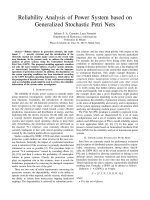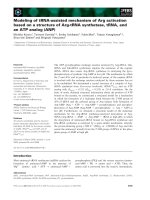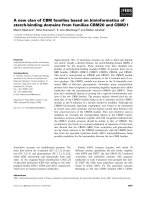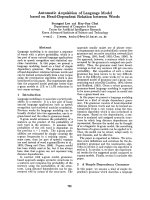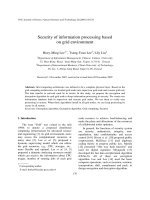Prediction of congenital hypothyroidism based on initial screening thyroidstimulating-hormone
Bạn đang xem bản rút gọn của tài liệu. Xem và tải ngay bản đầy đủ của tài liệu tại đây (545.85 KB, 5 trang )
Saleh et al. BMC Pediatrics (2016) 16:24
DOI 10.1186/s12887-016-0559-0
RESEARCH ARTICLE
Open Access
Prediction of congenital hypothyroidism
based on initial screening thyroidstimulating-hormone
David S. Saleh1,3*, Sarah Lawrence1, Michael T. Geraghty2, Patricia H. Gallego4, Karen McAssey5,
Diane K. Wherrett6 and Pranesh Chakraborty2,7*
Abstract
Background: In thyroid-stimulating-hormone (TSH)-based newborn congenital hypothyroidism (CH) screening
programs, the optimal screening-TSH cutoff level is critical to ensuring that true cases of CH are not missed.
Screening-TSH results can also be used to predict the likelihood of CH and guide appropriate clinical
management. The purpose of this study is to evaluate the predictive value of various screening-TSH levels
in predicting a diagnosis of CH in the Ontario Newborn Screening Program (ONSP).
Methods: The initial screening and follow-up data of 444,744 full term infants born in Ontario, Canada from April
1, 2006 to March 31, 2010 were analyzed. Confirmed CH cases were based on local endocrinologists’ report and
initiation of thyroxine treatment.
Results: There were a total of 541 positive screening tests (~1/822 live births) of which 296 were true positives
(~1:1,500 live births). Subjects were further subdivided based on screening-TSH and positive predictive values
(PPV) were calculated. Twenty four percent in the 17–19.9 mIU/L range were true positives. In the 17–30 mIU/L
range, 29 % were true positives with a significantly higher PPV for those sampled after (43 %) rather than before
(25 %) 28 h of age (p < 0.02). Seventy three percent of neonates with an initial screening-TSH of ≥ 30 mIU/L and
97 % of those with ≥ 40 mIU/L were later confirmed to have CH.
Conclusions: Infants with modestly elevated screening positive TSH levels between 17 and 19.9 mIU/L have a
significant risk (24 %) of having CH. The very high frequency of true positives in term newborns with initial TSH
values ≥ 30mIU/L suggests that this group should be referred directly to a pediatric endocrinologist in an effort
to expedite further assessment and treatment. Screen positives with a modestly elevated TSH values (17-19.9
mIU/L) need to be examined in more detail with extended follow-up data to determine if they have transient
or permanent CH.
Keywords: Congenital hypothyroidism, Thyroid stimulating hormone, Thyroid hormone, Newborn screening
Background
Thyroid hormone is essential for normal central nervous
system development – especially in the first 3 years of
life [1]. For children with untreated CH, the result is
permanent, irreversible cognitive delay, impaired motor
function and growth. This can be prevented by early
* Correspondence: ;
1
Division of Pediatric Endocrinology and Metabolism, Department of
Pediatrics, University of Ottawa, Ottawa, ON, Canada
2
Department of Pediatrics, University of Ottawa, Ottawa, ON, Canada
Full list of author information is available at the end of the article
detection and treatment [2, 3]. As a result, screening
programs to detect CH in the neonatal period were
developed in the early 1970’s and adopted by many
countries throughout the world. In Ontario, Canada, a
primary TSH with no second-tier test strategy has
been used by Newborn Screening Ontario (NSO) since
April 2006.
Since the introduction of screening programs, screeningTSH cutoffs and the predictive value of various screeningTSH levels has been the subject of debate [4–6], and a
variety of strategies are used. Some programs choose a
© 2016 Saleh et al. Open Access This article is distributed under the terms of the Creative Commons Attribution 4.0
International License ( which permits unrestricted use, distribution, and
reproduction in any medium, provided you give appropriate credit to the original author(s) and the source, provide a link to
the Creative Commons license, and indicate if changes were made. The Creative Commons Public Domain Dedication waiver
( applies to the data made available in this article, unless otherwise stated.
Saleh et al. BMC Pediatrics (2016) 16:24
standard TSH screen cutoff, often in the 20–30 mIU/L
range, and consider all newborns below the cutoff as negative for CH. Others choose 2 cutoffs: a standard cutoff, and
a second lower threshold, as low as 6 mIU/L. This second
group is considered “low-risk” for CH, and goes on to have
follow up thyroid function testing [4, 7]. In such programs
screening samples are typically collected at a later age,
which also explains the lower threshold in that we know
that TSH levels decline with time after birth. Regardless of
the strategy employed, there has long been established a
correlation between the initial screening-TSH level and the
risk of CH [8]. The primary purpose of this study is to formally evaluate the predictive value of the initial screeningTSH result in Ontario.
Methods
Subjects were identified from all newborns screened in
Ontario, Canada between April 1, 2006 and March 31,
2010. Confirmatory thyroid function testing bloodwork,
thyroid scan data and patient management information
was collected by the individual centre and submitted to
the ONSP. We collected all data directly from the
ONSP representing the 5 major pediatric centers in
Ontario. Aggregate NSO information is made publically
available in an annual report posted on the NSO website (www.newbornscreening.on.ca). The record level
data used for this analysis is not publically available.
Inquiries about access to NSO data should be directed
to Dr. Pranesh Chakraborty (Executive Director, NSO).
Stop date was chosen as a new data collection system
was implemented beyond this date. Inclusion criteria
included term newborns (≥37 weeks gestational age)
whose screening blood sample was collected later than
24 h of age. All newborns screened <24 h are routinely
re-screened with a bloodspot sample as part of NSO
protocol. Subjects of mothers who were reported to be
on anti-thyroid medication were excluded. Multiple
birth newborns were not excluded. Screening blood
samples were collected by heel stick bloodspot on filter
paper, and analyzed using an automated Perkin-Elmer
autoDELFIA immunoassay measuring TSH in mIU/L
blood volume. No changes to the assay occurred during
the study period. Newborns with an initial screeningTSH ≥17 mIU/L had confirmatory duplicate TSH bloodspot testing on the same sample and were referred to a
local physician for further evaluation and management if
the average of three TSH results was ≥ 17 mIU/L. Data
collected consisted of the short term follow up information routinely collected by NSO, including screening and
confirmatory TSH values, time of screening sample collection, gestational age, birth-weight and final diagnosis
(based on local physician’s report). Subjects were defined
as having true CH if they were started on thyroxine
replacement therapy at the discretion of their local
Page 2 of 5
endocrinologist – a decision based primarily on confirmatory plasma TSH and fT4 testing, and thyroid imaging (thyroid scan or ultrasound).
The Fisher Exact Test was used to compare positive
predictive values between age-of-sample collection
groups <28 and ≥ 28 h (median age of sample collection
was 28 h).
Patients in the study were anonymized and assigned a
unique study identifier number. This study was approved by the CHEO Research Ethics Board.
Results
Subjects included 444,744 term newborns born between
April 1, 2006 and March 31, 2010, of whom 541 newborns screened positive representing a screen positive
rate of approximately 1 in 822 newborns. Follow-up data
was available for all screen positive subjects, and 296
were later confirmed to have CH representing an incidence of approximately 1:1,500 term newborns.
Table 1 shows the positive predictive value and
sensitivity for various TSH screen cutoff levels. At a
screening-TSH cutoff of 17 mIU/L, 296 of 541 newborns were diagnosed with CH and started on treatment yielding a positive predictive value of 54.7 %. For
the purposes of this analysis, we made the assumption
that none of the 444,193 newborns who screened
negative actually had CH, yielding a sensitivity for the
program of close to 100 %. When the TSH screening
cutoff is increased to 20 mIU/L, although the positive
predictive value increases to 72.9 %, the sensitivity decreases significantly to 83.8 %.
Follow-up data from the 541 screen-positive infants
was then analyzed based on various screening-TSH
ranges (Table 2). Of the 201 newborns with screeningTSH results between 17–19.9 mIU/L, 48 were later confirmed to have CH, yielding a positive predictive value
(PPV) of 23.9 % for those who screen positive in this
range. The PPV increases to 39 % for screening-TSH
results of 20–29.9 mIU/L, 76.5 % for a screening-TSH
of 30–39.9 mIU/L, and 97.2 % for a screening-TSH ≥
40.0 mIU/L.
Newborns with ‘grey zone’ screening TSH of 17–29.9
mIU/L, the PPV was 30 % (98 of 330). Of confirmed
positive cases with screening TSH 17-29.9 mIU/L, 47 %
(20 of 43) had a low free T4 on confirmatory thyroid
function testing (according to local lab normal ranges),
compared with 66 % (63 of 96) of those whose screening
TSH was ≥30. Free T4 data was only available for 47 %
of cases. Of those subjects whose screening-TSH level
was 17–29.9 mIU/L, 27 % (12 of 45) had evidence of
thyroid dysgenesis on thyroid scan, versus 68 % (82 of
120) in the screening-TSH ≥30 mIU/L range (Table 3).
Thyroid scan data was only available for 56 % (165 of
294) of confirmed positives overall [46 % (45 of 98) in
Saleh et al. BMC Pediatrics (2016) 16:24
Page 3 of 5
Table 1 Positive predictive values and sensitivities for the CH
ONSP at various screening-TSH cutoff values
TSH Screen
Cutoff (mIU/L)
True Positives/
Screen Positives
Positive Predictive
Value (%)
Sensitivity
(%)
≥17
296/541
55 %
~100 %
≥20
248/340
73 %
84 %
≥30
198/211
94 %
67 %
≥40
172/177
97 %
58 %
≥50
157/159
99 %
53 %
the 17–29.9 mIU/L range, and 61 % (120 of 196) in the
screening-TSH ≥30 mIU/L range]. Although confirmatory serum TSH levels were likely drawn for all screen
positive patients as per standard clinical practice, we received data only 169/296 (57 %) of subjects. In 138 of
296 cases, we received confirmatory TSH, fT4 and thyroid scan data.
The PPV of newborns with screening-TSH levels
between 17–30 mIU/L and whose blood sample was collected at >28 h of age was significantly higher than those
whose samples were collected 24-28 h of age (43 % vs.
25 %; p = 0.002; Fig. 1).
Discussion
This cohort of 444,744 newborns yielding 541 screen
positive subjects represents one of the largest recently
published analyses of a CH screening program. The incidence of CH of 1:1,500 is comparable to reports in other
jurisdictions, although higher than most industrialized,
iodine replete countries and suggests efficient ascertainment of mild cases of CH [9]. Diagnosed newborns
include those with both permanent and transient forms
of CH. This could lead to over-diagnosis of CH as many
clinicians will treat confirmed screen positive patients
until 3 years of age, then reassess to determine if they
have a transient form of CH [10]. Elevated screening and
diagnostic TSH values can also be secondary to severe
illness [11], maternal TSH receptor blocking antibodies
[12], maternal iodine deficiency [13, 14] and excess [15],
infant exposure to iodine [16], errors in the screening
procedure, and newborns conceived by in vitro
fertilization [17] or delivered by caesarian section [18].
Table 3 Thyroid scan results for confirmed CH cases
Thyroid
Scan result
TSH 17–30 group
(frequency [%])
TSH >30 group
(frequency [%])
All Confirmed
Positive cases
Normal
Scan
28 [62]
33 [28]
61 [37]
Ectopic
gland
8 [18]
53 [44]
61 [37]
Athyrosis
1 [2]
29 [24]
30 [18]
Other
Dysplasia
3 [7]
0 [0]
2 [1]
All
Dysplasia
12 [27]
82 [68]
94 [57]
Decreased
uptake
5 [11]
5 [4]
10 [6]
Total
45
120
165
There is a wide range of screening-TSH cutoffs used
in neonatal screening programs including a low of 6
mIU/L in Wales [4], to a high of 30 mIU/L in Turkey
[19]. Much of this discrepancy has to do with the age of
sample collection (as TSH falls over the first few days of
life), or specific assay used to measure TSH. Hence, our
program’s data based on a TSH cutoff of 17 mIU/L may
not be generalizable to other programs that collect
bloodspot samples at different ages, or use a different
TSH immunoassay. Some programs use a TSH screen
cutoff of 20 mIU/L. Increasing the cutoff in Ontario
from 17 to 20 mIU/L would result in an unacceptable
decrease in sensitivity from 100 % to 84 %, thereby missing 16 % of currently identified cases. Of the 20 patients
with a screening TSH level in the 17–20 range, at least
Table 2 Positive predictive values for the CH ONSP at various
screening-TSH ranges
TSH Screen Range Screen
(mIU/L)
Positives
True
Positives
False
Positives
Positive
Predictive Value
17–19.9
201
48
153
24 %
20–29.9
129
50
79
39 %
30–39.9
34
26
8
76 %
≥40
177
172
5
97 %
Fig. 1 Scatter plot of screening-TSH level 17–30 mIU/L and age of
sample collection. Red triangles represent true positive subjects and
blue circles represent false positive subjects whose screening TSH level
was 17–30 mIU/L. Contours represent estimate of probability of CH for
any given screening-TSH/age of sample collection pair
Saleh et al. BMC Pediatrics (2016) 16:24
one had athyreosis indicated by thyroid scan (thyroglobulin level was not measured), and 9 had a low free
T4 values on confirmatory thyroid function testing, suggesting classical CH. This underscores the importance of
maintaining a low screening cutoff level of at most 17
mIU/L in order to detect an acceptable percentage of
those with CH.
The positive predictive value of newborns with mild to
moderate elevations of screening-TSH values in the 17–
30 range is 30 %. This increases significantly to 76 %
with a screening-TSH of 30-39.9 mIU/L, and to 97 %
with a screening-TSH ≥40 mIU/L. This is consistent
with a published report demonstrating that 41 % of newborns with TSH levels between 20–50 mIU/L had CH
[8]. Given the high PPV of 94 % for true CH with a
screening TSH over 30 mIU/L and the serious, permanent developmental consequences of untreated CH, we
propose that all such newborns should be referred
directly for specialist evaluation in an effort to expedite
further assessment and treatment.
Time of sample collection is important to consider in
conjunction with absolute screening-TSH value in predicting the likelihood of CH. When examining subjects
with mild to moderately elevated screening-TSH levels
of 17–30 mIU/L, the PPV in newborns whose sample
was collected ≥28 h of age was statistically higher than
those whose samples were collected at 24–28 h of age
(43 % vs. 25 %, p = 0.002). TSH-based screening programs could potentially use age of sample collection
data, in addition to absolute screening TSH level, as a
better tool for capturing true positive cases and predicting the risk of true CH (Fig. 1).
Limitations of this study include our assumption that
no infants with a screening-TSH result <17 mIU/L actually had CH, an assertion that may not be accurate.
There is no formal system in place that captures CH
patients who screen negative; however there were no reports of false negative screening results in children with
clinically identified CH during the study period. More
recently, there was one screen-negative infant confirmed
to have CH in the context of a strong family history of
hypothyroidism. This patient had a mild form of CH.
We would anticipate that most false screen-negative
patients would be brought to the attention of the program or participating pediatric endocrinologist, particularly those patients with permanent CH and significant
developmental morbidity secondary to untreated CH.
The diagnosis of CH was based on local endocrinologist report and initiation of thyroxine treatment. This
raises the limitations related to individual variations in
clinical practice as well as determination of transient
versus permanent CH. A Japanese study that found a
positive correlation between the prevalence of CH and regions with a lower concentration of adult and pediatric
Page 4 of 5
endocrinologists [20]. In Ontario, although non-specialists
physicians are occasionally involved in the management of
CH patients, the decision to treat is typically made by - or
in conjunction with - a pediatric endocrinologist in virtually all cases. This may have reduced but would not
eliminate the likelihood of overdiagnosis and treatment of
some screen positive children.
A proportion of subjects may have a transient or mild
form of CH, particularly those whose screening-TSH
level was in the lower end of the range. This notion is
supported by Kemper et al. who found that 38 % of children labeled as having CH by NBS no longer received
thyroxine by age 4 [21]. Treatment of such infants is
becoming increasingly controversial [6], as the neurodevelopmental consequences of withholding treatment in
such cases is unclear. Despite this, in our study, of those
subjects whose screening-TSH level was 17–29.9 mIU/L,
approximately 1 in 4 had evidence of thyroid dysgenesis
on thyroid scan, and nearly half had a low free T4 on
confirmatory thyroid function testing, suggesting the
possibility of clinically significant CH. Thyroid scan and
free T4 data was not available for all subjects. In
addition, all confirmatory TSH values reported to the
ONSP in confirmed cases (representing 57 % of cases)
were elevated above the reference range of the local
laboratory.
Further clinical and biochemical evaluation of confirmed cases 3 years post-diagnosis will be necessary to
conclusively determine the true incidence of permanent
CH. Unfortunately, this study was not designed to collect such information. Even complete imaging data
would be insufficient, as some forms permanent thyroid dyshormonogenesis have a normal thyroid imaging at diagnosis [22]. Although treatment of mild or
transient cases of CH is controversial, in the absence
of a clear way to distinguish transient and permanent
CH in the newborn period, and of data to support
conservative observation in those with transient CH,
treatment is indicated.
Conclusions
This study demonstrates that infants with modestly elevated screening-TSH values between 17–19.9 mIU/L
have a significant risk (24 %) of having CH. The high
frequency of true positives in those with screening-TSH
levels over 30 mIU/L suggests that this group should be
directly referred for specialist evaluation. Samples collected after 28 h of age have a significantly higher likelihood of being true positives with modest screening TSH
elevations in the 17–30 mIU/L range – a finding that
has possible implications in improving sensitivity and
accuracy of identifying CH cases. Those who screen
positive with TSH values between 17–20 mIU/L require
Saleh et al. BMC Pediatrics (2016) 16:24
further analysis and long-term follow up to determine if
they have transient versus permanent CH.
Abbreviations
TSH: Thyroid stimulating hormone; CH: Congenital hypothyroidism;
ONSP: Ontario newborn screening program; FT4: Free thyroxine; PPV: Positive
predictive value; NSO: Newborn screening Ontario.
Competing interests
The authors declare that they have no competing interests.
Authors’ contributions
DS contributed to the original design of the study, analyzed the data,
drafted the initial manuscript, and approved final manuscript as submitted.
SL conceptualized and contributed to the original design of the study,
reviewed and revised the manuscript, and approved the final manuscript as
submitted. PG, KM and DW were site supervisors at their respective
institutions and provided patient data, and reviewed and revised the
manuscript. MG contributed to the original study design and critically
reviewed the manuscript. PC was involved in the original design of the study
and data analysis, and approved the final manuscript as submitted. All
authors approved the final manuscript as submitted and agree to be
accountable for all aspects of the work.
Acknowledgements
Nick Barrowman completed all statistical analyses of the data in this study
and aided in interpretation of the data.
There were no funding sources for this study.
Page 5 of 5
8.
9.
10.
11.
12.
13.
14.
15.
16.
17.
Author details
1
Division of Pediatric Endocrinology and Metabolism, Department of
Pediatrics, University of Ottawa, Ottawa, ON, Canada. 2Department of
Pediatrics, University of Ottawa, Ottawa, ON, Canada. 3Department of
Pediatrics, Queen’s University, Kingston, ON, Canada. 4Department of
Pediatrics, University of Western Ontario, London, ON, Canada. 5Division of
Pediatric Endocrinology, Department of Pediatrics, McMaster University,
Hamilton, ON, Canada. 6Division of Endocrinology, Department of Pediatrics,
Hospital for Sick Children, University of Toronto, Toronto, ON, Canada.
7
Newborn Screening Ontario, Children’s Hospital of Eastern Ontario, Ottawa,
Canada.
18.
Received: 22 October 2014 Accepted: 27 January 2016
22.
References
1. Porterfield SP, Hendrich CE. The role of thyroid hormones in prenatal and
neonatal neurological development – current perspectives. Endocr Rev.
1993;14:94–106.
2. Dubuis JM, Glorieux J, Richer F, Deal CL, Dussault JH, Van Vliet G.
Outcome of severe congenital hypothyroidism: Closing the
developmental gaps with early high dose levo-thyroxine treatment.
J Clin Enodcrinol Metab. 1996;81:222–7.
3. Bongers-Schokking JJ, de Muinck Keizer-Schrama SM. Influence of timing
and dose of thyroid hormone replacement on mental, psychomotor, and
behavioral development in children with congenital hypothyroidism.
J Pediatr. 2005;147:768–74.
4. Pryce RA, Gregory JW, Warner JT, John R, Bradley D, Evans C. Is the current
threshold level for screening for congenital hypothyroidism too high? An
audit of the clinical evaluation, confirmatory diagnostic tests and treatment
of infants with increased blood spot thyroid-stimulating hormone
concentrations identified on newborn blood spot screening in Wales. Arch
Dis Child. 2007;92:1048.
5. Korada M, Pearce MS, Ward Platt MP, Avis E, Turner S, Wastell H, et al.
Difficulties in selecting an appropriate neonatal TSH screening threshold.
Arch Dis Child. 2010;95:169–73.
6. Krude H, Blankenstein O. Treating patients not numbers: the benefit
and burden of lowering TSH newborn screening cut-offs. Arch Dis
Child. 2011;96:121–2.
7. UK Newborn Screening Programme Centre: Newborn blood spot screening in
the UK. Policies and Standards, 2005. Accessed 1 Feb 2016.
19.
20.
21.
Klett M. Epidemiology of congenital hypothyroidism. Exp Clin Endocrinol
Diabetes. 1997;105:19–23.
Kempers MJ, Lanting CI, van Heijst AFJ, Trotsenburg ASP, Wiedijk BM, de
Vijlder JJM, et al. Neonatal screening for congenital hypothyroidism based
on thyroxine, thyrotropin, and thyroxine-binding globulin measurement:
potentials and pitfalls. J Clin Endocrinol Metab. 2006;91:3370–6.
Parks JS, Lin M, Grosse SD, Hinton CF, Drummond-Borg M, Borgfeld L, et al.
The impact of transient hypothyroidism on the increasing rate of congenital
hypothyroidism in the United States. Pediatrics. 2010;125:S54–63.
Simpson J, Williams FL, Delahunty C, van Toor H, Wu SY, Ogston SA, et al.
Serum thyroid hormones in preterm infants and relationships to indices of
severity of intercurrent illness. J Clin Endocrinol Metab. 2005;90:1271–9.
Brown RS, Bellisario RL, Botero D, Fournier L, Abrams CA, Cowger ML, et al.
Incidence of transient congenital hypothyroidism due to maternal
thyrotropin receptor-blocking antibodies in over one million babies. J Clin
Endocrinol Metab. 1996;81:1147–51.
Burns R, Mayne PD, O’Herlihy C, Smith DF, Higgins M, Stains A, et al. Can
neonatal TSH screening reflect trends in population iodine intake? Thyroid.
2008;18:883–8.
Ares S, Quero J, Morreale de Escobar G. Neonatal iodine deficiency: clinical
aspects. J Pediatr Endocrinol Metab. 2005;18 suppl 1:1257–62.
Connelly KJ, Boston BA, Pearce EN, Sesser D, Snyder D, Braverman LE, et al.
Congenital hypothyroidism caused by excess prenatal maternal iodine
ingestion. J Pediatr. 2012;161:760–2.
Smith VC, Cvoren BM, Wolfsodorf JI. Hypothyroidism in a breast-fed preterm
infant resulting from maternal topical iodine exposure. J Pediatr.
2006;149:56–567.
Sakka S, Malamitsi-Puchner A, Loutradis D, Chrousos GP, Kanaka-Gantenbein
C. Euthyroid hyperthyrotropinemia in children born after in vitro fertilization.
J Clin Endocrinol Metab. 2009;94:1338–41.
McElduff A, McElduff P, Wiley V, Wilcken B. Neonatal thyrotropin as
measured in a congenital hypothyroidism screening program: Influence of
the mode of delivery. J Clin Endocrinol Metab. 2005;90:6361–1.
Buyukgebiz A. Newborn screening for congenital hypothyroidism. J Ped
Endo Metab. 2006;19:1291–8.
Gu YH, Kato T, Harada S, Inomata H, Aoki K. Time trend and geographic
distribution of treated patients with congenital hypothyroidism relative to the
number of available endocrinologists in Japan. J Pediatr. 2010;157:153–7.
Kemper AR, Ouyang L, Grosse SD. Discontinuation of thyroid hormone
treatment among children in the United States with congenital
hypothyroidism: findings from health insurance claims data. BMC Pediatr.
2010;10:9.
Schoen EJ, Clapp W, To TT, Fireman BH. The key role of newborn thyroid
scintigraphy with isotopic iodide (123I) in defining and managing congenital
hypothyroidism. Pediatrics. 2004;114:e683–8.
Submit your next manuscript to BioMed Central
and we will help you at every step:
• We accept pre-submission inquiries
• Our selector tool helps you to find the most relevant journal
• We provide round the clock customer support
• Convenient online submission
• Thorough peer review
• Inclusion in PubMed and all major indexing services
• Maximum visibility for your research
Submit your manuscript at
www.biomedcentral.com/submit
